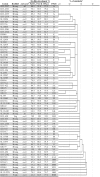Antibiotic Susceptibility of Biofilm Cells and Molecular Characterisation of Staphylococcus hominis Isolates from Blood
- PMID: 26659110
- PMCID: PMC4685997
- DOI: 10.1371/journal.pone.0144684
Antibiotic Susceptibility of Biofilm Cells and Molecular Characterisation of Staphylococcus hominis Isolates from Blood
Abstract
Objectives: We aimed to characterise the staphylococcal cassette chromosome mec (SCCmec) type, genetic relatedness, biofilm formation and composition, icaADBC genes detection, icaD expression, and antibiotic susceptibility of planktonic and biofilm cells of Staphylococcus hominis isolates from blood.
Methods: The study included 67 S. hominis blood isolates. Methicillin resistance was evaluated with the cefoxitin disk test. mecA gene and SCCmec were detected by multiplex PCR. Genetic relatedness was determined by pulsed-field gel electrophoresis. Biofilm formation and composition were evaluated by staining with crystal violet and by detachment assay, respectively; and the biofilm index (BI) was determined. Detection and expression of icaADBC genes were performed by multiplex PCR and real-time PCR, respectively. Antibiotic susceptibilities of planktonic cells (minimum inhibitory concentration, MIC) and biofilm cells (minimum biofilm eradication concentration, MBEC) were determined by the broth dilution method.
Results: Eighty-five percent (57/67) of isolates were methicillin resistant and mecA positive. Of the mecA-positive isolates, 66.7% (38/57) carried a new putative SCCmec type. Four clones were detected, with two to five isolates each. Among all isolates, 91% (61/67) were categorised as strong biofilm producers. Biofilm biomass composition was heterogeneous (polysaccharides, proteins and DNA). All isolates presented the icaD gene, and 6.66% (1/15) isolates expressed icaD. This isolate presented the five genes of ica operon. Higher BI and MBEC values than the MIC values were observed for amikacin, vancomycin, linezolid, oxacillin, ciprofloxacin, and chloramphenicol.
Conclusions: S. hominis isolates were highly resistant to methicillin and other antimicrobials. Most of the detected SCCmec types were different than those described for S. aureus. Isolates indicated low clonality. The results indicate that S. hominis is a strong biofilm producer with an extracellular matrix with similar composition of proteins, DNA and N-acetylglucosamine; and presents high frequency and low expression of icaD gene. Biofilm production is associated with increased antibiotic resistance.
Conflict of interest statement
Figures



Similar articles
-
Microbiological and molecular characterization of Staphylococcus hominis isolates from blood.PLoS One. 2013 Apr 9;8(4):e61161. doi: 10.1371/journal.pone.0061161. Print 2013. PLoS One. 2013. PMID: 23585877 Free PMC article.
-
[In vitro effect of vancomycin and daptomycin on biofilm formation of coagulase-negative staphylococci strains].Mikrobiyol Bul. 2017 Jul;51(3):220-235. doi: 10.5578/mb.57435. Mikrobiyol Bul. 2017. PMID: 28929959 Turkish.
-
Human methicillin-sensitive Staphylococcus aureus biofilms: potential associations with antibiotic resistance persistence and surface polysaccharide antigens.J Basic Microbiol. 2014 Jul;54(7):721-8. doi: 10.1002/jobm.201200557. Epub 2013 May 17. J Basic Microbiol. 2014. PMID: 23686411
-
[Molecular basis of methicillin-resistance in Staphylococcus aureus].Rev Chilena Infectol. 2018;35(1):7-14. doi: 10.4067/s0716-10182018000100007. Rev Chilena Infectol. 2018. PMID: 29652966 Review. Spanish.
-
Molecular mechanisms of biofilm-based antibiotic resistance and tolerance in pathogenic bacteria.FEMS Microbiol Rev. 2017 May 1;41(3):276-301. doi: 10.1093/femsre/fux010. FEMS Microbiol Rev. 2017. PMID: 28369412 Review.
Cited by
-
Effects of Flavonoids and Antibiotics Combination on Preformed Biofilms and Small RNA of Staphylococcus aureus.Indian J Microbiol. 2023 Sep;63(3):307-316. doi: 10.1007/s12088-023-01086-5. Epub 2023 Aug 23. Indian J Microbiol. 2023. PMID: 37781018 Free PMC article.
-
Exploring the Biofilm Formation Capacity in S. pseudintermedius and Coagulase-Negative Staphylococci Species.Pathogens. 2022 Jun 16;11(6):689. doi: 10.3390/pathogens11060689. Pathogens. 2022. PMID: 35745543 Free PMC article.
-
Refractory postoperative Staphylococcus hominis bacteremia in a patient with an ACTH-producing pancreatic neuroendocrine neoplasm: a case report.Surg Case Rep. 2022 Jun 29;8(1):126. doi: 10.1186/s40792-022-01485-8. Surg Case Rep. 2022. PMID: 35764761 Free PMC article.
-
Ecology and resistance to UV light and antibiotics of microbial communities on UV cabins in the dermatology service of a Spanish hospital.Sci Rep. 2023 Sep 4;13(1):14547. doi: 10.1038/s41598-023-40996-8. Sci Rep. 2023. PMID: 37666842 Free PMC article.
-
In vitro Effects of Antimicrobial Agents on Planktonic and Biofilm Forms of Staphylococcus saprophyticus Isolated From Patients With Urinary Tract Infections.Front Microbiol. 2019 Jan 28;10:40. doi: 10.3389/fmicb.2019.00040. eCollection 2019. Front Microbiol. 2019. PMID: 30745897 Free PMC article.
References
-
- Al Wohoush I, Rivera J, Cairo J, Hachem R, Raad I. Comparing clinical and microbiological methods for the diagnosis of true bacteraemia among patients with multiple blood cultures positive for coagulase-negative staphylococci. Clin Microbiol Infect. 2011;17(4):569–71. 10.1111/j.1469-0691.2010.03372.x - DOI - PubMed
-
- Sunbul M, Demirag MK, Yilmaz O, Yilmaz H, Ozturk R, Leblebicioglu H. Pacemaker lead endocarditis caused by Staphylococcus hominis . Pacing Clin Electrophysiol. 2006;29(5):543–5. - PubMed
Publication types
MeSH terms
Substances
LinkOut - more resources
Full Text Sources
Other Literature Sources
Medical
Molecular Biology Databases
Miscellaneous

